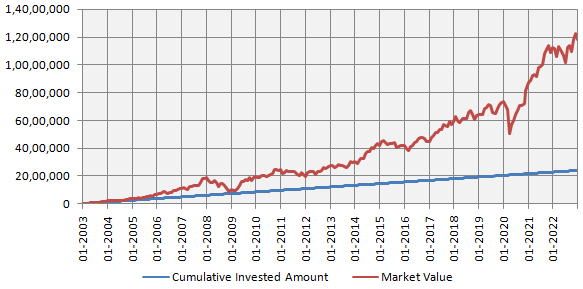Tue Jan 24 00:00:00 UTC 2023
Why ELSS works not just for tax saving but also wealth creation

As we approach the end of FY 2022-23 / AY 2023-24, you should ensure that you complete the tax planning for this year by 31st March 2023 for availing the tax benefits available under various sections of Income Tax Act, 1961. If you are unable to complete the tax planning before the deadline set by your company or before 31st March 2023, whichever is earlier, you may see a big TDS deduction in your March pay-slip or you may have to pay additional income tax with interest when you file your Income Tax Returns (ITR).
Tax savings under Section 80C
Tax payers can claim deductions of up to Rs 1.5 lakhs every year from their gross taxable income by investing in various schemes allowed in Section 80C of Income Tax Act. You can save up to Rs 46,800 in taxes by investing in 80C schemes. Eligible investments under Section 80C are Voluntary Provident Fund (VPF), Public Provident Funds (PPF), National Savings Certificates (NSC), 5 year tax saverfixed deposits, life insurance plans (traditional and unit linked), mutual fund Equity Linked Savings Schemes (ELSS) etc. You should understand that while VPF, PPF, NSC and 5 year tax saver FDs are risk free investments, ELSS and Unit Linked Insurance Plans (ULIPs) are subject to market risks.
Equity Linked Savings Schemes
Equity Linked Savings Schemes are diversified equity mutual funds with a lock-in period of 3 years. These funds diversify across different industry sectors and market capitalization segments. You can start investing in ELSS with Rs 100 only. There is no upper limit of investments in ELSS; however, you can claim tax deduction of up to Rs 1.5 lakhs u/s 80C. ELSS funds are open-ended but redemptions are not allowed before completion of 3 years from date of investment. You can invest in SIP either in lump sum or through SIP. If you are investing in ELSS through SIP, then each SIP installment will be locked in for 3 years.
Wealth creation by ELSS
Many tax payers make 80C investments purely for the purpose of tax savings. However, your investments should have some objective, other than purely tax savings. It can be capital appreciation or income generation.
Historical data shows that equity, as an asset class, has the potential of giving superior returns in the long term. In the last 20 years (ending 31st December 2022) Nifty 50 TRI has given 16.6% compounded annual growth rate (CAGR) returns (source: NSE, Advisorkhoj Research, as on 31st December 2022. Disclaimer: Past performance may or may not be sustained in the future).
The chart below shows how much wealth you could have accumulated through a monthly SIP of Rs 10,000 in Nifty 50 TRI over the last 20 years (ending 31st December 2022). With a cumulative investment of Rs 24 lakhs, you could have accumulated a corpus of nearly Rs 1.2 crores over the last 20 years. This chart clearly demonstrates the wealth creation potential of equity as an asset class over long investment horizons.

Source: NSE, Advisorkhoj Research, as on 31st December 2022. Disclaimer: Past performance may or may not be sustained in the future
The chart above shows the wealth creation potential of equity as an asset class. ELSS funds are actively managed schemes which invest across industry sectors and market capitalizations segments. Since ELSS funds can invest across market capitalizations segments, there is opportunity for fund managers to create alphas (give higher risk adjusted returns than market benchmark) by investing in a bigger universe of stocks, which have potential of giving higher returns due to growth or value opportunities. The three year lock-in period enables ELSS fund managers to invest in high conviction stocks for a long period of time because of relatively less redemption pressure.
Tax advantage of ELSS
Taxation on redemption or maturity proceeds should be an important consideration in making informed investment decisions. While EPF, VPF and PPF maturity proceeds are tax free, interest income on VPF contributions in excess of Rs 2.5 lakhs in a financial year, will be taxed as per your income tax rate. 5 year tax saver Bank FD interest is taxed as per your income tax rate. The interest component in NSC maturity proceeds is also taxed as per your income tax rate but the accrued interest every year can be claimed as part of 80C deductions for the year. Life insurance maturity proceeds are tax free, as long as the premium does not exceed 10% of the sum assured (for policies issued before 1st April 2022) or 20% of the sum assured (for policies issued before 1st April 2022). ELSS is one of the most tax efficient 80C investment options. Capital gains of up to Rs 1 lakh in ELSS investments is tax exempt in a financial year and taxed at 10% plus applicable surcharge and cess thereafter.
Who should invest in ELSS?
- Investors looking to save taxes by investing in schemes eligible u/s 80C. You can save up to Rs 46,800 per year in taxes by investing in ELSS.
- Investors who are looking for capital appreciation or wealth creation over long investment tenures.
- Investors should have minimum 3 year investment horizons for ELSS. Though you can redeem your ELSS units partially or fully after the completion of 3 years from date of investment, you should have long investment horizons for ELSS – the longer your investment horizon, higher will be the wealth creation potential of your investment.
- Investors should have moderately high to high risk appetites for ELSS.
- Tax saving investments u/s 80C must be made before 31st March of a financial year, if you want to claim the benefits for the same year. You must plan accordingly.
You should consult with your financial advisor or mutual fund distributor regarding your tax planning and discuss if ELSS is suitable for your tax planning and long term investment needs.
Mutual Fund Investments are subject to market risk, read all scheme related documents carefully.